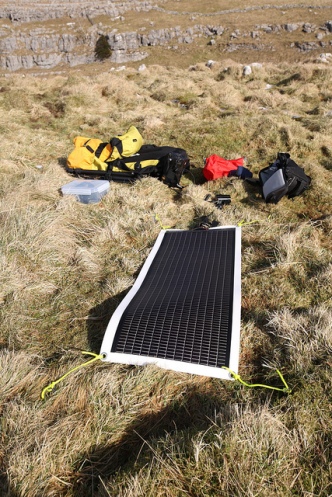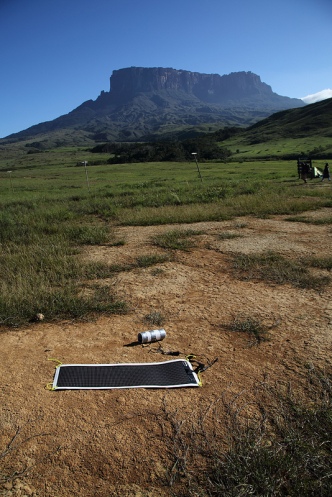These great bundles are still available online! Start your holiday shopping now for the persona in your life that is always on the go and needs to stay connected!
Monday, September 22, 2014
Friday, September 12, 2014
Check out this great blog article on the use of a PowerFilm Portable Solar Charger for the use use of photography!
Solar Charging Canon Digital SLR Camera Batteries
http://rowancastle.wordpress.com/2014/01/20/solar-charging-canon-digital-slr-camera-batteries/
Why consider investing in a solar charging system?
I tend to specialize in travel photography – and perhaps more specifically adventure travel. This often involves trekking for long periods far from a mains power supply. In the past, when I used Canon film SLR cameras, this did not present any difficulties. The film cameras I used (from 2000 to 2006) were powered by one or two disposable lithium batteries, which were fairly cheap. In addition, the cameras themselves used little power. It was easily possible to do a three week trek and take all the photographs I needed without having to change the batteries at all.
This all changed when I switched to digital SLR cameras, which by comparison are power hungry. The energy they require to power the LCD display, the camera sensor and internal processors is considerable. Also, the tendency with digital photography is to take many more photographs than was possible in the days of film. As a result, these cameras are powered by beefy rechargeable lithium batteries that are not only heavy, but also very expensive (typically around £50 each for an O.E.M. brand battery from Canon). Changing or upgrading your camera system will often necessitate investing in a whole new type of battery to power that particular camera, adding to the expense.
For travel photography in general, this arrangement still doesn’t present too many problems. When backpacking around, even to some quite remote locations – there is usually a source of electricity available (even if it comes from a generator and might be limited to certain times of day). All that is usually required in the kit bag is a travel adaptor and the camera battery charger. However, trekking for several weeks through the wilderness far from any source of electricity is a completely different scenario, and this was the problem I was facing last year when I was due to undertake a three week trek in the mountains of northern Pakistan. It was then that I decided to investigate (and invest in) a method to solar charge the Canon LP-E6 batteries that power my EOS 5D Mk III camera. I thought that I would share my experiences in this blog and hopefully this will be of use to other photographers.
The Equipment
There are several videos on youtube showing the set-up required for solar charging, but one concern I had was that they often didn’t show the exact equipment and wiring required. As it turns out, the equipment is quite simple. There are two basic configurations – one system involves using a solar panel to trickle charge a storage battery (and the camera battery is recharged from the storage battery) and the other is to directly charge the battery from the solar panel. I opted for the latter system, to save weight (I didn’t want to carry the storage battery when trekking) and expense (the storage battery is expensive).
To directly charge my Canon dSLR camera batteries, I opted to purchase a PowerFilm roll-able 14 Watt solar panel. At maximum power, this will deliver 15.4V and 900mA, although the manufacturers suggest that in good conditions, a charging current of approximately 400mA should be expected. I ordered my solar panel from www.sundancesolar.com in the United States. They sell this panel as part of a solar charging kit for Canon cameras. You can specify your model of dSLR when you order.
The solar charging kit they supplied consisted of:
*The PowerFilm R14 Solar Panel
*A Cigarette Lighter socket (and cable)
*A 3rd Party Manufacturer Canon LP-E6 battery charger with cigarette lighter adapter
Of course, to make this kit ‘trek-ready’ and more likely to survive the rigours of the great outdoors, I added a few things to it. Firstly, in very windy conditions, the solar panel could just blow away. It might also be useful to be able to attach it to the roof of a tent. The panel has tie-down holes around the edges, so I attached a length of paracord at each corner. I also invested in four very lightweight titanium tent pegs, which can be tied to the end of each piece of cord and used to stake the solar panel to the ground. Secondly, the manufacturers warned that the panel should not be rolled up too tightly (from memory, less than 2 inches diameter) or it would be damaged. Hand rolling it without exceeding this limitation was tricky, time consuming and annoying. I solved the problem by using the cardboard tube that some bottles of Scotch whisky are sold in. I found one that had the correct diameter (i.e. slightly larger than 2 inches), and could now just roll the solar panel around it. This also had the advantage that the whisky tube (which has a metal lid) could be used to store the battery charger and the cigarette lighter socket / cable (and also I got to drink the whisky of course!). Thirdly, to make it easy to attach the kit to the outside of my rucksack, I bought a small water resistant stuff sack.
Solar Charging
With the equipment described above, the charging process itself is fast and easy. I just unroll the solar panel in a position where it will catch all the sunlight available, attach the cigarette lighter socket / cable to the connector on the panel, and plug the charger (don’t forget, this charger has a cigarette lighter adapter for power and is designed to work from a 12V source, it can’t be connected to the mains) into the cigarette lighter socket. Finally, the LP-E6 battery is slotted into the charger.
Field Tests
Before taking the equipment on a long expedition, I wanted to test it out. The first test was just simply to see if it would work, and was done on a fairly sunny day in February, in the Yorkshire Dales. It did indeed start charging up my battery (which was deliberately at just less than full charge). In the short time it took my friend and I to have lunch, the battery charger was indicating that the battery was fully charged. I did make one modification to the set up after this test. I noticed that the battery was a bit loose in the 3rd party charger, and also the charger was quite flimsy. I decided to upgrade to the Canon LP-E6 car charger. This charger is eye-wateringly expensive, but it is (according to Canon) able to supply a higher current from the 12V supply and looks and feels much more robust.
Photo: Testing the Solar Charger
The second (and final) test I did was a bit more scientific. I wanted to get a fair indication of how long it would take to fully charge an LP-E6 battery using the solar charger. I picked an ideal day in May – there wasn’t a cloud in the sky and the sun was beating down. In this test it took 58 minutes to increase the battery charge by 25%. That suggests that under ideal conditions, it would take around 4 hours to fully charge an LP-E6 battery (rather better than I was expecting).
Performance In The Wilderness
Unfortunately, my intended trek in Pakistan was cancelled at the last minute, and I opted to climb Mount Roraima in Venezuela instead. This was only an 8-day trek (rather than the 22 days that the trek in Pakistan would have taken) but I decided to take the solar charging kit with me to see how it performed under really testing conditions. My plan was to use the charger to top up my battery(ies) in the mornings/evenings in camp, and also during lunch breaks. In that way I hoped to get perhaps three hours a day of charging time.
There were a few factors that meant I didn’t get to use the charger as often as I think I would have done in Pakistan:
• Our lunch stops were much shorter than they would have been on a Himalayan trek (often we just had a packed lunch).
• As Venezuela is in the tropics, it gets dark very early in the evening, so there was not much sunlight left after we arrived in camp.
• The top of Mount Roraima is often shrouded in cloud
• As Venezuela is in the tropics, it gets dark very early in the evening, so there was not much sunlight left after we arrived in camp.
• The top of Mount Roraima is often shrouded in cloud
Despite these problems, I did manage to do some charging with the solar panel, especially on the trek to the base of the mountain, which crossed the savanna where it was both hot and sunny.
Photo: My Solar charger with Kukenan Tepui in the background (Venezuela)
There is no doubt that the solar charger worked and it did increase the charge on the batteries that I used it on. However, I did hit an unexpected snag. I found that the Canon charger would for some reason (even in strong sunshine) occasionally enter an error state where the charging light would start flashing orange rapidly. The only way to restart the charge was to unplug it and plug it back in again. This was not ideal because my aim was to really just be able to leave the charger out in the sun and forget about it, whereas I had to continually check on it to make sure it was still charging. I spoke to Canon about this problem and they could not really identify what the fault was. Apparently the Canon brand charger is so expensive because it contains a lot of electronics designed to protect the battery from incorrect voltages. I’m still not sure why this would have caused the fault, but it is possible that the charger was getting too high a voltage in the very bright tropical sun, or perhaps overheated. I could not replicate this fault back in the UK (where the light only flashed orange when the sky clouded over and the sunlight hitting the panel dropped right off). I intend to do some more testing soon, but this time using the 3rd party charger, which might be a little less ‘fussy’ about variations in the output from the panel (but possibly at the expense of the longevity of the battery).
Conclusion
There is no doubt that solar charging is practical and does work, but I think my system just needs a bit more testing to get the best out of it. There really is no other option for very long treks in the wilderness and I think that over time the high initial outlay will probably pay for itself in battery costs. However, until I get the bugs ironed out I will still be taking a healthy supply of batteries with me on very long treks.
The above article is in no way affiliated with Californiapc.com, nor is an endorser for this company. It is simply an article of relativity to our products and interests.
For more information on PowerFilm Solar and similar products go to www.CaliforniaPC.com, sales@californiaPC.com or 1-949-487-1213.
Subscribe to:
Comments (Atom)






